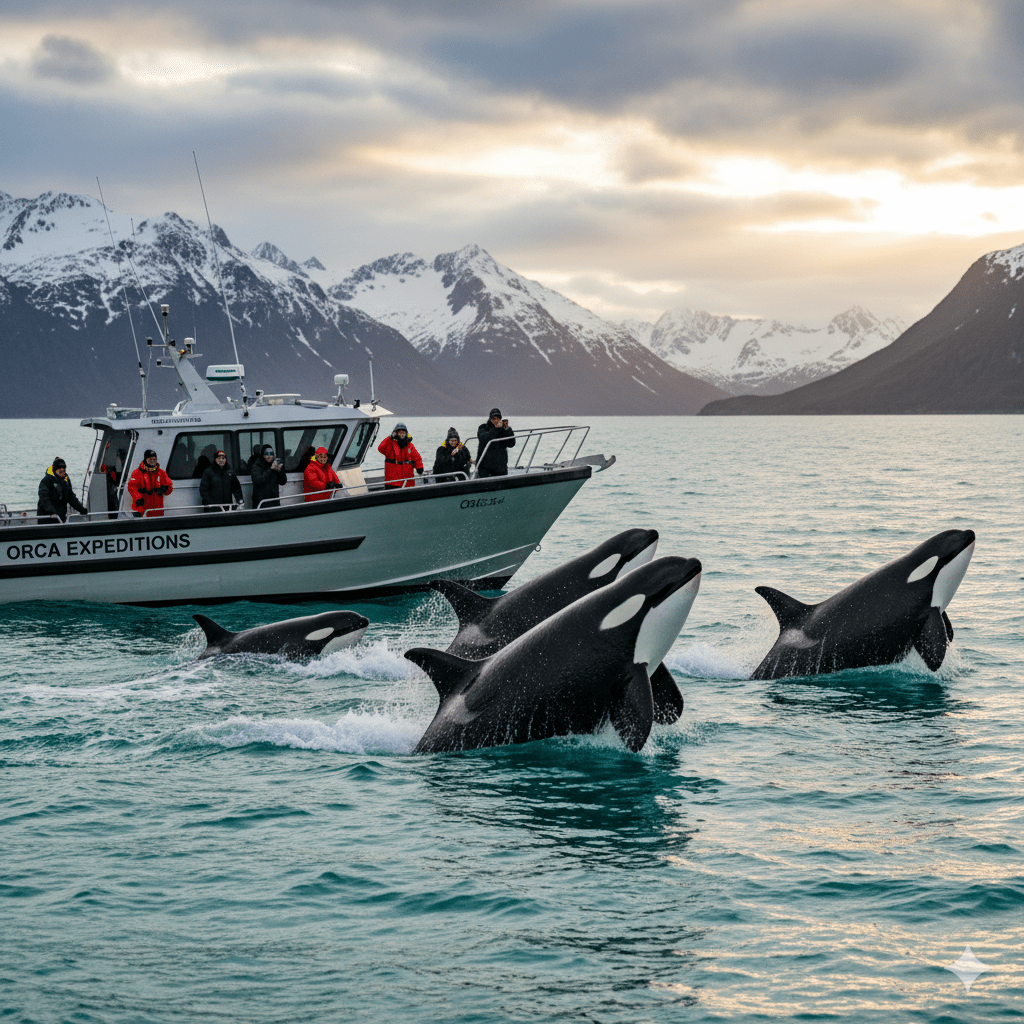
Catching a glimpse of animals in their natural habitat can be rare. Orcas, also known as killer whales, are amazing natural predators that are most easily viewed at aquatic theme parks or on television documentaries. Instead of supporting organizations that confine animals and use them for entertainment purposes, I recommend viewing orcas in their natural habitat.
One of the best locations to visit orcas is in the Puget Sound. I am writing this as the best blog for moms looking for natural outings with their children and families.
The Intelligence and Struggles of Orcas
Orcas are some of the most intelligent creatures in the world, and their ability to stealthily hunt as a pack is incredible, to say the least. Sadly, these animals have been poorly treated by humans in the past. Because of their intelligence and trainability, humans have capitalized on them in the form of shows for a paying audience. Most orcas used for this purpose were not bred in captivity.
Rather, the whales were taken from their pods and sold to theme parks around the world, where they were forced to live in small tanks and suboptimal conditions. Even for whales bred in captivity, it’s a sad life.
Puget Sound: A Natural Habitat for Orcas
The waters of Puget Sound, located right off Seattle’s coast in the Pacific Northwest, are home to several pods of orcas. Puget Sound is part of a complex estuarine system that provides a rich environment for diverse marine life. Killer Whales and other whales are frequently spotted here, thanks in large part to the nutrient-rich waters that support their primary food, salmon. The Sound’s protected waters are also ideal for orcas to travel, hunt, and bond in their pods.
My Experience in Seattle
I was recently in the Seattle area, and I was extremely excited about the possibility of viewing orca pods living their normal lives in open water. It is not uncommon for residents to encounter orcas when venturing across the Sound by ferry boat. Ferry delays occur when the orca pods intercept the ferry routes, as there are strict laws for allowing a proper distance between boats and whales. I think it is wonderful that the humans in this part of the world are careful to protect wildlife.
Best Time to See Orcas in Puget Sound
If you are planning a trip to the Seattle area and would like to have a chance to experience orcas (and other whales), you should time your visit for the spring and summer (May to September), as these months are ideal, as the waters of Puget Sound teem with salmon that attract orcas. It’s also when whale-watching tours operate most regularly. Sightings are rarer during the winter months (October through April), but this is when you might spot transient orcas venturing into the Puget Sound.
Where to See Orcas Near Seattle
San Juan Islands
Less than two hours from Seattle (by ferry or car), the San Juan Islands, especially near Friday Harbor, provide some of the best whale-watching opportunities in the region. Tours departing from here increase the likelihood of seeing a pod.
Alki Beach, West Seattle
For land-based viewing, head to Alki Beach. On occasion, local residents post about orca sightings near this scenic shoreline. Bring binoculars for a better chance to spot them.
Point Defiance, Tacoma
Located south of Seattle, the waters near Point Defiance are frequented by transient orcas. Tacoma’s shoreline provides a good vantage for spotting these marine giants.
Whale Watching Tours
Numerous tour operators, such as Puget Sound Express or Island Adventures, offer tailored whale-watching experiences departing from locations like Edmonds, Seattle, and Anacortes. These trips often feature guides who provide educational commentary. When I was up in the Puget Sound area, I did not sign up for any specific type of whale tour. I did, however, visit The Langley Whale Center on Whidbey Island, where I was thoroughly educated on Orcas and the best means to stay in touch about local sightings.
Types of Orcas in Puget Sound
I learned that there are two main types of orcas in the Puget Sound: Resident Orcas and Transient Orcas.
- Resident Orcas
The Resident Orcas feed exclusively on salmon and live in three pods identified as J, K, and L pods. Because salmon numbers are so low, this particular whale pod is endangered. - Transient Orcas
The Transient Orcas, otherwise known as Bigg’s Orcas, have adapted to eating various types of prey, and their numbers are staying strong. The Bigg’s Killer Whales are the ones that put on a show for spectators. They will eat everything from porpoises to seals to even birds! If you are not a fan of watching nature do its thing (sometimes in a brutal way), then a whale-watching tour might not be a good idea… Because — quite frankly — you will see death.
Responsible Orca Watching
When viewing orcas, remember that their survival depends on minimizing disruptions to their natural behavior. Follow these guidelines to ensure your encounter is ethical:
- Always maintain a distance of at least 300 yards from Southern Resident orcas (or any whales, per Washington State law).
- Avoid speeding boats near pods, and reduce noise pollution as much as possible.
- Support eco-friendly tours that prioritize animal safety.
- Never feed or try to touch the whales; they are wild animals requiring minimal human interaction.
A Magical Experience
Encountering orcas in Puget Sound is nothing short of magical. Viewing these amazing aquatic mammals will leave you with butterflies in your stomach. To maximize your chances of spotting them, be sure to plan your trip for the best time of year, the most ideal location, and use the online resources to find out where the pods have most recently been spotted. Don’t forget your binoculars!
Viewing them will be at a distance, and unless you have fighter-pilot vision, you will need some magnification to really appreciate them in motion.
Children will really enjoy this experience! It is important that the younger generation is educated on wildlife preservation, especially that of endangered species, as it will be their job to ensure we care for our planet. Seeing Orcas in the wild will burn a beautiful memory into your mind and heart for a lifetime.
Educational Benefits
Aside from the incredible experience of witnessing orcas in their natural habitat, there are also many educational benefits to this activity. Here are just a few:
- Learning about marine ecosystems: By observing orcas in the wild, you can gain a better understanding of how they interact with their environment and other species. This can provide insight into the delicate balance of marine ecosystems and how important it is to protect them.
- Understanding the behavior of orcas: Seeing these majestic creatures in their natural habitat allows for a more accurate observation of their behavior. You may be able to witness hunting techniques, communication between individuals, and social dynamics within pods.
- Appreciating conservation efforts: Orca are an iconic and beloved species, but they are also facing threats such as pollution, overfishing, and habitat destruction. Learning about conservation efforts and organizations dedicated to protecting them can inspire individuals to get involved and make a difference.
Conclusion
Orcas are fascinating and intelligent creatures that deserve our admiration and protection. Through learning about their physical characteristics, behavior, and conservation efforts, we can gain a deeper understanding and appreciation for these magnificent animals.
So next time you come across an article or documentary about killer whales, take a moment to dive deeper into their world and learn something new about these incredible creatures.
Frequently Asked Questions
How long do orcas live?
Orcas live 50-80 years in the wild.
What is the average size of an orca?
The average size of an orca is about 23-32 feet in length and weighs between 6,000 and 12,000 pounds. However, males can grow up to 30 feet in length and weigh over 22,000 pounds.
Do orcas live in groups?
Yes, orcas are highly social animals and typically live in matrilineal pods consisting of several generations of females and their offspring. These pods can range from a few individuals to as many as 40 members.
How do orcas communicate?
Orcas have a complex system of communication that includes vocalizations, body language, and even physical touch. They also use echolocation to navigate and hunt for food.
